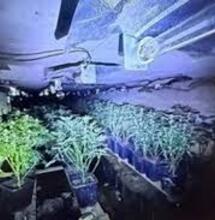Grow Natural

Mother Nature; we all love her, right? She provides us with everything we need, including our favourite plants. But how many of us would choose to trust her to feed our plants completely and resist the urge to top up with mineral boosters?
Mother Nature; we all love her, right? She provides us with everything we need, including our favourite plants. But how many of us would choose to trust her to feed our plants completely and resist the urge to top up with mineral boosters?
Mother Nature; we all love her, right? She provides us with everything we need, including our favourite plants. But how many of us would choose to trust her to feed our plants completely and resist the urge to top up with mineral boosters?
To be honest, I’ve always been a fan of mineral feeds. I can be a bit of a control freak when it comes to the grow room, I like the fact that growing indoors allows you to ‘play God’ and manipulate every environmental factor influencing the growth of your plants to squeeze out a few additional percentages of yield. I like the fact that you can increase the uptake of specific elements by adjusting the pH and add different elements to control the development of the plants accordingly.
Don’t get me wrong, I’ve always believed that organics has its place; it’s great for beginners who want to keep things simple or for growers doing a few plants for themselves and want the ultimate in taste. I’ve used organics indoors and outdoors and had some great tasting results, but always thought that the yield suffered, plus I’ve sampled some great tasting weed that has been grown on mineral feed. I also know, having been around commercial crop growers for a few years, that the majority of them don’t use organic techniques because it’s difficult to get consistency on a large scale.
So, I’ve never really been a 100% bio convert.
However, when I recently received a phone call off a mate who was experimenting with some slow release organic feed and was seriously impressed with the results, my curiosity got the better of me. The friend in question was playing around with some Green Crack (from Humboldt Seed Organisation, seems to have plenty of buzz around it in the UK at the moment) in AutoPots and 60/40 mix. Alongside his 4 plants in 60/40 mix and mineral feed, he’d also been running 4 plants in a light mix soil with BioTabs slow release food that had been given to him by his friendly local hydro shop – free samples, one of the many reasons to support your local grow shop and stop buying shit on eBay!
Basically, he explained, you mix all the feed into your growing media, activate it with some gloopy molasses-type mixture and then feed plain tap water for the full crop cycle… and that’s it. Some further inspection revealed that the programme consists of two types of feed; one that’s a powder and is available to the plant almost immediately and one that is a slow release tablet, plus Mycorrhiza and beneficial bacteria additives and the gloopy liquid is a booster that activates everything.
So far, so simple. No need to adjust pH or add feed to the tank as the beneficials and slow release tablets work in symbiosis to produce food for the entire life of the plant. I was sceptical, but the results spoke for themselves. The 4 plants in the BioTabs under a 600watt lamp produced a smidge over 500grams dry and, although it isn’t 1gram per watt, that isn’t far off the magic number. Now the plants on the mineral feed produced around 15% more yield but, even I had to admit, there was a difference in taste and smell and for ease of use – particularly if you’re interested in quality rather than quantity – they were really impressive (so much so that I’m doing this article!).
This got me thinking that I’d been a little hasty to dismiss organics altogether and maybe I should look a little closer at what Mother Nature has to offer. So, I asked around a few shops and grower friends to see what other natural products they recommended.
Worm humus and bat guano cropped up as widely used soil amendments. Worm humus is a great all round soil conditioner and contains a healthy dose of nitrogen whilst the phosphorus content from bat guano means it’s ideal to top dress and water through into your soil at the beginning of the flowering period. In fact, a couple of the guys I chatted to swerved mineral nutrients entirely and instead used an All Mix or Royalty Mix soil and just top dressed bat guano in the flowering period. Hand feeding their plants with water throughout the grow. Simples.
Most that I spoke to – myself included – had some knowledge and first-hand experience of the benefits of using a Mycorrhiza inoculant when rooting out their plants, so much so that many of them referred to it a grow room essential. For those of you that have never tried using Mycorrhiza in your grow, I urge you to do it. This beneficial fungi is sprinkled around the roots every time you transplant; it binds itself to the roots and breaks down food in the growing media to make it more available to the plant, whilst simultaneously feeding off the waste products that the plants put out. This symbiotic relationship significantly increases root development and nutrient uptake and is a completely natural process. It’s one of those products where you literally see the benefits within days.
Finally, one product that all of the shops mentioned was insect frass… that’s beetle larvae shit in layman’s terms. This interesting product can be used in a multitude of ways; top dressing onto your pots, diluted and watered through or even mixed into a foliar spray. The most common way, however, is to mix it into your growing media before you pot up, at a rate of around a litre of frass per 50 litres of media. The frass provides a range of macro and micro-nutrients, is packed full of beneficial microorganisms (more than 450 million colony forming units of beneficial bacteria per gram!) and also contains chitin, a modified polysaccharide found in cell walls of insects (well, it is made from beetle shit!). The benefits include; improved nutrient availability and root growth, elevated resistance to pests and disease and a healthy kick (or ‘Charge’) in growth from the available macro and micro-nutrients. The consensus was, it’s well worth a try.
So, there’s a few examples of natural products to stick on the Christmas list and try for next year. All of them can be added to a mineral feed programme, so can still be used even if you don’t feel like making the full switch to organics. Give them a go and let Mother Nature give you a helping hand.
Happy growing!



